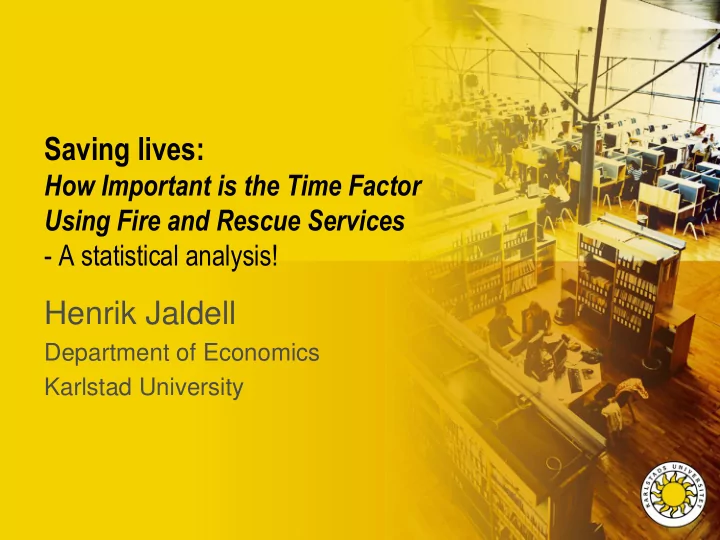

Saving lives: How Important is the Time Factor Using Fire and Rescue Services - A statistical analysis! Henrik Jaldell Department of Economics Karlstad University
Economics • Decision rule : If benefits outweigh costs go on with the project. • Here : Should we try to reduce the response time? – Benefits : Saved lives, reduced injuries, saved property value, reduced environmental damage – Investments cost money (not considered here) – Only saved lives considered in this study. Costs € Benefits € – Only fires in residential homes (even if a reduction in response time affects all types of rescues) – No cost-benefit analysis (CBA) done in this study. henrik.jaldell@kau.se
Background: The monetary value of fire and rescue service responses (2004) Percent of 5 minutes, Weighted Type of rescue responses Kronor value % Fires in buildings 137 800 22 30 900 Traffic accidents 86 200 25 21 500 Drowning 267 900 1 3 200 Fires other than buildings 5 000 34 1 700 Hazardous substances 3 900 4 150 Water 1 100 4 50 Values include Landslides 14 200 0.2 25 • Lives Animals 800 2 15 • Injuries • Property value Storms 250 2 5 • Environmental Other rescues 26 300 6 1 500 damage Weighted sum 58 900 100 58 900 henrik.jaldell@kau.se
Background: The monetary value of fire and rescue service responses (2004) Percent of 5 minutes, Weighted Type of rescue responses Kronor value % Fires in buildings 137 800 22 30 900 - lives and personal injuries 6 000 1300 residential homes Traffic accidents 86 200 25 21 500 Drowning 267 900 1 3 200 Fires other than buildings 5 000 34 1 700 Hazardous substances 3 900 4 150 Water 1 100 4 50 Values include Landslides 14 200 0.2 25 • Lives Animals 800 2 15 • Injuries • Property value Storms 250 2 5 • Environmental Other rescues 26 300 6 1 500 damage Weighted sum 58 900 100 58 900 henrik.jaldell@kau.se
Time, definition
Time, theoretical relationship ”Marginal effect ”
Data • Focuses on residential homes (incl. nursing homes) in Sweden, which are where 3/4 of all fatalities due to fires happen. • Uses data from the fire and rescue services response reports for nine years, 2005-2013 . • 51998 reports with 630 fatalities (0.012 per turn-out) • (NB. not all fatalities in fires registered by the fire and rescue service, about 20% missing) henrik.jaldell@kau.se
Result. Fires in residential homes Statistically estimated relation. Response time → Risk of fatality . Risk of fatality Response time, seconds
Results, Marginal effects Marginal effect Lives saved per i.e. how many lives are saved per Per response year if response minute and minute time reduced by one minute At 1 minute 0.00156 At 2.5 minutes 0.00078 At 5 minutes 0.00046 At 10 minutes 0.00027 At 20 minutes 0.00016 At mean (=570 seconds) 1.9 0.00032 At median (=480 seconds) 0.00027 1.6 • There are 5800 turn-outs per year to residential homes. • A one minute decreased response time would then lead to a 2.8% reduction of the fatalities.
Results – Type of building Blocks of Detached Semi- Summer/ Nursing flats houses detached/ winter homes terraced houses houses No of turn-outs per year 2 490 2 310 170 210 230 Percent of turn-outs with 1.1 % 1.1 % 1.4 % 1.0 % 0.5 % fatalities Median response time, 380 660 460 900 390 seconds Marginal effect, 0.00047 0.00024 0.00034 0.00020 0.00038 lives saved per minute at median Lives saved per year if 1.20 0.60 0.06 0.06 0.10 response time reduced by one minute
Results – Starting reason Percent Mean no. of of fatalities fatalities Overall 100 % 0.012 Unknown 61.9 % 0.042 Smoking 14.9 % 0.045 With intention (Arson) 5.9 % 0.009 Stove 4.0 % 0.003 Technical failure 3.0 % 0.004 Heat transfer 1.9 % 0.004 Candlelight 1.6 % 0.006 Sparks 1.4 % 0.011 Explosion 0.6 % 0.046 Children playing 0.5 % 0.007 Chimney fire 0.2 % 0.0001 Other 4.0 % 0.005
Results – Starting reason Percent Mean no. of of fatalities fatalities Overall 100 % 0.012 Unknown 61.9 % 0.042 Smoking *** 14.9 % 0.045 With intention (Arson) *** 5.9 % 0.009 Stove 4.0 % 0.003 Technical failure 3.0 % 0.004 Heat transfer 1.9 % 0.004 Candlelight 1.6 % 0.006 Sparks 1.4 % 0.011 Explosion 0.6 % 0.046 Children playing 0.5 % 0.007 Chimney fire 0.2 % 0.0001 Other 4.0 % 0.005 *** = Response time has statistical significant larger marginal effect
Conclusions : • Every year there are about 6 000 turn-outs to residential homes in Sweden, and about 90 fatalities. • Assume the response time could be reduced by 1 minute on average (Average today = 9.4 minuter) – The statistically estimated curve indicates that this could save 2 lives per year . • Largest marginal effect in blocks of flats • Largest marginal effect for fires caused by smoking or with intention • Small changes in response time would result in small changes in risk of fatalities. – To reduce fatalities from fires perhaps concentrate on other things (i.e. more cost efficient) • However, large changes in response time could result in large changes in risk of fatalities. – Example: 30 min → 8 min reduces risk of fatality by 25 %! • Results indicated that the response time is about 3 times more important in this study than in Jaldell (2004). • Published as: Jaldell, H. (2017) How Important is the Time Factor? Saving Lives Using Fire and Rescue Services, Fire Technology, 53(2):695-708, https://doi.org/10.1007/s10694-016-0592-4 henrik.Jaldell@kau.se
Recommend
More recommend